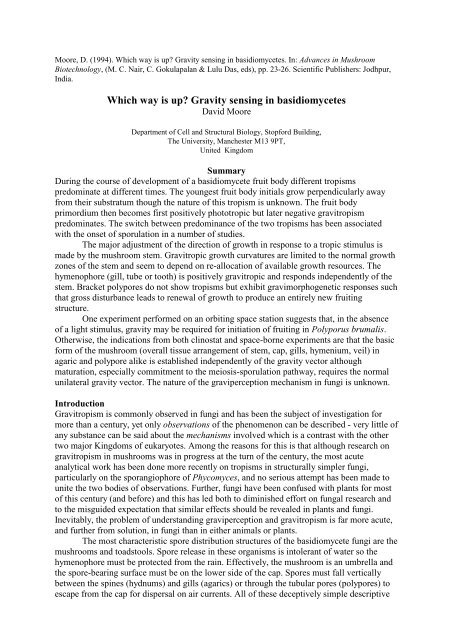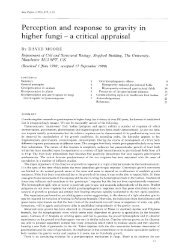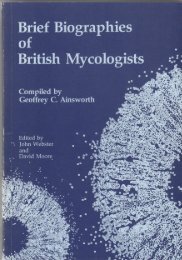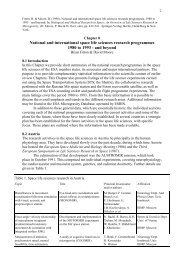Moore, 1994 - David Moore's World of Fungi: where mycology starts
Moore, 1994 - David Moore's World of Fungi: where mycology starts
Moore, 1994 - David Moore's World of Fungi: where mycology starts
You also want an ePaper? Increase the reach of your titles
YUMPU automatically turns print PDFs into web optimized ePapers that Google loves.
<strong>Moore</strong>, D. (<strong>1994</strong>). Which way is up? Gravity sensing in basidiomycetes. In: Advances in Mushroom<br />
Biotechnology, (M. C. Nair, C. Gokulapalan & Lulu Das, eds), pp. 23-26. Scientific Publishers: Jodhpur,<br />
India.<br />
Which way is up? Gravity sensing in basidiomycetes<br />
<strong>David</strong> <strong>Moore</strong><br />
Department <strong>of</strong> Cell and Structural Biology, Stopford Building,<br />
The University, Manchester M13 9PT,<br />
United Kingdom<br />
Summary<br />
During the course <strong>of</strong> development <strong>of</strong> a basidiomycete fruit body different tropisms<br />
predominate at different times. The youngest fruit body initials grow perpendicularly away<br />
from their substratum though the nature <strong>of</strong> this tropism is unknown. The fruit body<br />
primordium then becomes first positively phototropic but later negative gravitropism<br />
predominates. The switch between predominance <strong>of</strong> the two tropisms has been associated<br />
with the onset <strong>of</strong> sporulation in a number <strong>of</strong> studies.<br />
The major adjustment <strong>of</strong> the direction <strong>of</strong> growth in response to a tropic stimulus is<br />
made by the mushroom stem. Gravitropic growth curvatures are limited to the normal growth<br />
zones <strong>of</strong> the stem and seem to depend on re-allocation <strong>of</strong> available growth resources. The<br />
hymenophore (gill, tube or tooth) is positively gravitropic and responds independently <strong>of</strong> the<br />
stem. Bracket polypores do not show tropisms but exhibit gravimorphogenetic responses such<br />
that gross disturbance leads to renewal <strong>of</strong> growth to produce an entirely new fruiting<br />
structure.<br />
One experiment performed on an orbiting space station suggests that, in the absence<br />
<strong>of</strong> a light stimulus, gravity may be required for initiation <strong>of</strong> fruiting in Polyporus brumalis.<br />
Otherwise, the indications from both clinostat and space-borne experiments are that the basic<br />
form <strong>of</strong> the mushroom (overall tissue arrangement <strong>of</strong> stem, cap, gills, hymenium, veil) in<br />
agaric and polypore alike is established independently <strong>of</strong> the gravity vector although<br />
maturation, especially commitment to the meiosis-sporulation pathway, requires the normal<br />
unilateral gravity vector. The nature <strong>of</strong> the graviperception mechanism in fungi is unknown.<br />
Introduction<br />
Gravitropism is commonly observed in fungi and has been the subject <strong>of</strong> investigation for<br />
more than a century, yet only observations <strong>of</strong> the phenomenon can be described - very little <strong>of</strong><br />
any substance can be said about the mechanisms involved which is a contrast with the other<br />
two major Kingdoms <strong>of</strong> eukaryotes. Among the reasons for this is that although research on<br />
gravitropism in mushrooms was in progress at the turn <strong>of</strong> the century, the most acute<br />
analytical work has been done more recently on tropisms in structurally simpler fungi,<br />
particularly on the sporangiophore <strong>of</strong> Phycomyces, and no serious attempt has been made to<br />
unite the two bodies <strong>of</strong> observations. Further, fungi have been confused with plants for most<br />
<strong>of</strong> this century (and before) and this has led both to diminished effort on fungal research and<br />
to the misguided expectation that similar effects should be revealed in plants and fungi.<br />
Inevitably, the problem <strong>of</strong> understanding graviperception and gravitropism is far more acute,<br />
and further from solution, in fungi than in either animals or plants.<br />
The most characteristic spore distribution structures <strong>of</strong> the basidiomycete fungi are the<br />
mushrooms and toadstools. Spore release in these organisms is intolerant <strong>of</strong> water so the<br />
hymenophore must be protected from the rain. Effectively, the mushroom is an umbrella and<br />
the spore-bearing surface must be on the lower side <strong>of</strong> the cap. Spores must fall vertically<br />
between the spines (hydnums) and gills (agarics) or through the tubular pores (polypores) to<br />
escape from the cap for dispersal on air currents. All <strong>of</strong> these deceptively simple descriptive
2<br />
statements depend upon detection <strong>of</strong> gravity and modulation <strong>of</strong> growth processes by reference<br />
to the direction <strong>of</strong> the gravity vector. The ‘umbrella’ fruit body must grow upwards; the<br />
hymenophore must be on the lower surface; and spines, gills or pores must be vertical.<br />
The most striking gravitropic reactions were reported by Schmitz (22, 23) and Sachs<br />
(20, 21); establishing the basic facts that agaric stipes are negatively gravitropic and the gills<br />
positively gravitropic. More experimental work was done in the early years <strong>of</strong> this century (3-<br />
6, 12, 25) and there have been a number <strong>of</strong> studies since then. Most <strong>of</strong> the research bears<br />
literally on tropic responses to gravity, rather than on morphogenetic responses.<br />
Gravitropism in hymenomycetes<br />
Different groups <strong>of</strong> hymenomycetes exhibit different gravitropic responses (10). In most<br />
agarics and polypores the hymenophore may be the main centre <strong>of</strong> gravitropic growth. On the<br />
one hand the hymenophore has its own orientation mechanism assuring positively gravitropic<br />
growth, and on the other hand there is evidence that the hymenophore may influence growth<br />
<strong>of</strong> the stem. Species <strong>of</strong> Coprinus exhibit a different pattern - the gills are not gravitropic and<br />
the stem alone is responsible for spatial orientation. Finally, bracket fungi are probably best<br />
considered to show gravimorphogenetic rather than gravitropic reactions. After their position<br />
is changed the direction <strong>of</strong> growth changes in the meristemoid zones and only the newly<br />
formed parts <strong>of</strong> the fruit body are vertical. The fruit body as a whole, though, is not<br />
gravitropic.<br />
Gravitropism develops as the hymenomycete fruit body grows. The very youngest<br />
fruit body initials grow perpendicularly away from the surface on which they arise<br />
independently <strong>of</strong> the direction <strong>of</strong> light or gravitational signals (3, 4, 18, 24), a reaction which<br />
may be analogous to the avoidance reactions <strong>of</strong> Phycomyces sporangiophores (8, 14, 17).<br />
As they develop further, the stems <strong>of</strong> ground agarics (gilled mushrooms) are generally<br />
non-phototropic but show a marked negative gravitropism <strong>where</strong>as lignicolous and<br />
coprophilous hymenomycetes are <strong>of</strong>ten both phototropic and gravitropic (18). Usually, an<br />
initial period <strong>of</strong> light-seeking growth in the earliest stages <strong>of</strong> development is followed by<br />
negative gravitropism. Gravitropism <strong>of</strong> the stem provides the ‘coarse’ adjustment <strong>of</strong> fruit<br />
body position, the ‘fine’ adjustment is done by the positively gravitropic hymenophore.<br />
Buller (4, [pp. 51-52]) showed that all the gills <strong>of</strong> Agaricus campestris could readjust<br />
to the vertical providing the cap was not tilted beyond 30. These responses can be quite<br />
rapid. Buller (4, 5) detected the gravitropic adjustment <strong>of</strong> the gills <strong>of</strong> Agaricus within an hour<br />
and states: ‘If one turns a [Coprinus] fruit-body from a vertical to a horizontal position, the<br />
stipe begins to turn up the pileus within about three minutes after first receiving the geotropic<br />
stimulus’ (4, [pp. 69-70]). At the other end <strong>of</strong> the spectrum, the responses can be maintained<br />
for very long periods. In bracket polypores the tubes <strong>of</strong>ten extend vertically downwards for<br />
considerable distances and as many <strong>of</strong> these fruit bodies are perennial, this gravitropic growth<br />
may continue for many years (5, [p. 112]).<br />
Gravimorphogenetic effects<br />
Polarity <strong>of</strong> the primordium, the relative positions <strong>of</strong> stipe, hymenophore and cap tissues and<br />
the initial distribution <strong>of</strong> agaric gills, are all aspects <strong>of</strong> early mushroom morphogenesis which<br />
might be influenced by gravity, but these could all equally well be controlled by nongravitational<br />
cues. The obvious experimental approach is to remove suspected cues and study<br />
the progress <strong>of</strong> events in their absence. Unfortunately, the influence <strong>of</strong> gravity can only be<br />
escaped in orbital laboratories, although a number <strong>of</strong> earthbound devices can help. The<br />
clinostat distributes the effect <strong>of</strong> gravity around its axis <strong>of</strong> rotation, to some extent simulating<br />
hypogravity - a reduced gravitational field (though actually being an omnilateral as opposed<br />
to the usual unilateral gravity exposure), whilst centrifuges permit increase in the apparent
gravitational field (actually centripetal acceleration) - the hypergravity experience.<br />
Clinostat experiments<br />
Hasselbring (12) investigated the effect <strong>of</strong> growth on a clinostat on development <strong>of</strong><br />
Polystictus (= Pycnoporus) cinnabarinus, Schizophyllum commune and Coprinus spp and<br />
Reijnders (19, [p. 316]), Plunkett (18) and Badham (1) also report clinostat experiments.<br />
Unfortunately, most <strong>of</strong> these are <strong>of</strong> very limited value because the authors report only selected<br />
results (‘... only a few gave results ...’ (12); ‘The results given relate to cases <strong>where</strong> no<br />
obvious arrest to development occurred’ (18). However, Hasselbring reports hymenophore<br />
formation over the whole surface <strong>of</strong> clinostated fruit bodies <strong>of</strong> Pycnoporus cinnabarinus and<br />
S. commune and Plunkett (18) states: ‘In the two fruit-bodies studied extremely shallow<br />
hymenial tubes, 1 mm. deep, were produced but developed no further.’ These are the first<br />
reports <strong>of</strong> morphogenesis being disturbed by absence <strong>of</strong> a unilateral gravity vector.<br />
The most recent, and undoubtedly the most carefully executed, clinostat experiments<br />
by Gorovoj, Kasatkina & Laurinavichius (11) used Polyporus brumalis, Panus (= Lentinus)<br />
tigrinus and Coprinus cinereus. These showed a consistent absence <strong>of</strong> the tubular<br />
hymenophore in fruit bodies <strong>of</strong> Polyporus brumalis arising on cultures grown on the clinostat.<br />
A series <strong>of</strong> five experiments were performed, each with 4 replicate cultures, but in no case<br />
was any sign observed <strong>of</strong> the typical tubular hymenophore, or even <strong>of</strong> the network <strong>of</strong><br />
dissepiments which initiates it. In some experiments Gorovoj et al. (11) placed samples on<br />
the clinostat with fruit bodies in different stages <strong>of</strong> development, clinostating being continued<br />
until mature fruit bodies were obtained. In those in which cultures consisted only <strong>of</strong><br />
mycelium at the start, the mature fruit bodies had a smooth hymenophore surface; in the<br />
second series <strong>of</strong> cultures which bore fruit body rudiments up to 5 mm in size when transferred<br />
to the clinostat, the mature fruit bodies had the lower surface <strong>of</strong> the caps covered with blebs<br />
(the very earliest stage in formation <strong>of</strong> dissepiments) and in some places the cap even had a<br />
small network <strong>of</strong> dissepiments; and in the third series, comprising cultures which initially<br />
bore fruit bodies whose caps had begun to differentiate, the mature fruit bodies had a network<br />
<strong>of</strong> dissepiments on the lower surface <strong>of</strong> the cap. However, formation <strong>of</strong> the normal tubular<br />
hymenophore did not occur in any <strong>of</strong> the samples. These results parallel those obtained by the<br />
earlier workers and imply that the unilateral gravity vector is required for formation <strong>of</strong> the<br />
tubular hymenophore. Microscopically, there were no major anatomical differences in the<br />
structure <strong>of</strong> fruit bodies grown on the clinostat compared with control but hymenial cells in<br />
clinostat cultures stopped development at the dikaryon stage. Karyogamy was rarely observed<br />
and basidia with spores were infrequently seen.<br />
The situation was quite similar in C. cinereus grown on the clinostat, as no normal,<br />
spore-yielding, fruit bodies were obtained. However, in C. cinereus clinostat growth did not<br />
impair progress through the initial stages <strong>of</strong> development; all the main parts <strong>of</strong> the fruit body -<br />
cap, stem, hymenophore, and veil - were formed, but all remained underdeveloped. As in<br />
Polyporus, it seems that the unilateral gravity vector is required for normal progress through<br />
meiosis and sporulation; in its absence Coprinus fruit body development stops prior to spore<br />
formation.<br />
In contrast, the greatest influence <strong>of</strong> the clinostat on Lentinus tigrinus was on<br />
morphogenesis <strong>of</strong> the stem. This formed numerous branches rather than a cap. Thus, it seems<br />
that in this organism absence <strong>of</strong> a unilateral gravity stimulus results in loss <strong>of</strong> polarity and<br />
apical dominance.<br />
Experiments in orbit<br />
Test-tube cultures <strong>of</strong> Polyporus brumalis were flown during an orbital space flight aboard the<br />
unmanned Soviet ‘biosputnik’, Cosmos 690 (26). The Cosmos 690 cultures were in orbit for<br />
20 days during which time they were in the dark. In the absence <strong>of</strong> illumination, fruit body<br />
3
4<br />
caps were not formed but the stems <strong>of</strong> the fruit bodies grew well so this experiment<br />
demonstrated that at least the early stages <strong>of</strong> fruiting could occur in zero gravity. Further<br />
experiments were conducted, again with Polyporus brumalis, during flights (in 1977-78) <strong>of</strong><br />
the manned space stations Salyut-5 and Salyut-6 (15, 16). In the experiment conducted aboard<br />
Salyut-5 cultures bearing fruit body rudiments up to 2 mm tall were taken aboard the space<br />
station and some were incubated with illuminated while others were in darkness. All formed<br />
fruit bodies, those in the dark failed to form caps, as expected; those grown in the light were<br />
similar to normal and had a tubular hymenophore, although the hymenium was restricted to<br />
the bottom <strong>of</strong> the tubes (16). In the experiment on Salyut-6, cultures were delivered to the<br />
space station bearing mycelium only. Again, cultures were incubated in weightless conditions<br />
either in the light or dark. Fruit bodies were formed in the light, but most <strong>of</strong> the fruit bodies<br />
had no hymenophore and little hymenium. No fruit bodies were formed in the dark although<br />
in dark-grown controls on earth fruit body rudiments were formed in the dark. The Salyut<br />
dark-grown cultures were shown to be able to fruit when illuminated after recovery so it<br />
seems that some aspect <strong>of</strong> the fruit body initiation process in the dark requires the gravity<br />
vector.<br />
The limited experiments done in orbit seem to support the conclusion from clinostat<br />
experiments that it is hymenophore development which is most dependent on the gravity<br />
vector. They also suggest that a clinostat <strong>of</strong> the design used by Gorovoj et al. (11), with a<br />
rotation speed <strong>of</strong> 2 r.p.m., is a good analogue <strong>of</strong> the ‘zero’ gravity state.<br />
Hypergravity - enhanced gravitational fields<br />
The device used by Gorovoj et al. (11) incorporated a centrifuge able to apply centrifugal<br />
accelerations <strong>of</strong> 1 and 4.5 g. Hypergravitation, though, did not greatly affect fruit body<br />
morphogenesis either macroscopically or microscopically and the normal gravitropic<br />
reactions occurred.<br />
Perception <strong>of</strong> the gravitational impulse<br />
Perception <strong>of</strong> gravity is potentially quite different from perception <strong>of</strong> other stimuli because<br />
there is no gravitational gradient. The perception system must depend on gravity establishing<br />
an asymmetric distribution <strong>of</strong> matter within the organism. Gravity-induced asymmetries<br />
might include (a) differences in hydrostatic pressure between ‘top’ and ‘bottom’; (b)<br />
differences in forces <strong>of</strong> compression or extension between the ‘top’ and ‘bottom’ <strong>of</strong> rigid<br />
structures; (c) changes caused by movement <strong>of</strong> extracellular or intracellular structures relative<br />
to immovable parts <strong>of</strong> the cell or tissue.<br />
Little work has been done to establish the location and nature <strong>of</strong> the structures<br />
responsible for perception <strong>of</strong> gravity in hymenomycetes. Borriss (2), described ‘... particles <strong>of</strong><br />
plasma, ... situated in about the centre <strong>of</strong> the cell ...’ in Coprinus lagopus (= C. cinereus?).<br />
Gooday (9) states that ‘The cytology <strong>of</strong> geotropism <strong>of</strong> stipes <strong>of</strong> Coprinus cinereus was<br />
investigated by the late G. H. Banbury (personal communication) ... light and electron<br />
microscopy ... showed that when horizontal, the distribution <strong>of</strong> cell contents was displaced so<br />
that the vacuole occupied most <strong>of</strong> the upper part, and the cytoplasm ... the lower part.’ These<br />
two accounts appear to be the only reports <strong>of</strong> any cytological examination <strong>of</strong> gravitropism in<br />
hymenomycetes.<br />
Much more attention has been devoted to the sporangiophores <strong>of</strong> Phycomyces but the<br />
cytology has also been neglected. Dennison & Shropshire (7) provide the only evidence (but<br />
only at the light microscope level) <strong>of</strong> an intracellular reorganization in response to<br />
reorientation <strong>of</strong> the sporangiophore, concluding ‘The existence <strong>of</strong> protoplasmic asymmetry is<br />
a plausible first step in the gravireceptor stimulus-response chain...’ and ‘...the gravireceptor<br />
mechanism ... must involve the rearrangement <strong>of</strong> intracellular liquid phases <strong>of</strong> differing
density, specifically the protoplasm and vacuole’. Channelling <strong>of</strong> chitosomes and other<br />
peripheral vesicles into the lower part <strong>of</strong> the cell would indeed be an attractive explanation<br />
for greater expansion growth on one side <strong>of</strong> the hypha rather than the other side in relation to<br />
current models <strong>of</strong> wall growth. However, because <strong>of</strong> the astonishing absence <strong>of</strong> cytological<br />
observation and experimentation it remains the case that no sensory apparatus has been<br />
identified in any fungus. Furthermore, Lilian Hawker (13) wrote in 1950: ‘It is desirable that<br />
research should be directed towards an interpretation <strong>of</strong> tropisms in fungi based on the study<br />
<strong>of</strong> growth-regulators. At present nothing is known <strong>of</strong> any mechanism in fungi comparable to<br />
the redistribution <strong>of</strong> auxins in the higher plants.’ Sadly, this is still true 40 years later, so we<br />
are also totally ignorant <strong>of</strong> the growth co-ordination processes which respond to the gravityperception<br />
system.<br />
Acknowledgements: I thank the organisers <strong>of</strong> this Symposium and the Mycological Society<br />
<strong>of</strong> India for their kind invitation to contribute this review. Sincere thanks are also due to Julia<br />
Cranston for her translations from the German and, most especially, to Vera Sokolovski for<br />
her astonishingly careful and skilful translations <strong>of</strong> the Russian papers.<br />
References<br />
(1) Badham, E. R. 1982. Tropisms in the mushroom Psilocybe cubensis. Mycologia 74: 275-<br />
279.<br />
(2) Borriss, H. 1934. Beiträge zur Wachstums- und Entwicklungsphysiologie der<br />
Fruchtkörper von Coprinus lagopus. Planta 22: 28-69.<br />
(3) Buller, A. H. R. 1905. The reactions <strong>of</strong> the fruit-bodies <strong>of</strong> Lentinus lepideus, Fr., to<br />
external stimuli. Ann. Bot. 19: 427-438.<br />
(4) Buller, A. H. R. 1909. Researches on <strong>Fungi</strong>, vol. 1. Longman Green & Co.: London.<br />
(5) Buller, A. H. R. 1922. Researches on <strong>Fungi</strong>, vol. 2. Longman Green & Co.: London.<br />
(6) Buller, A. H. R. 1924. Researches on <strong>Fungi</strong>, vol. 3. Longman Green & Co.: London.<br />
(7) Dennison, D. S. & Shropshire, W. 1984. The gravireceptor <strong>of</strong> Phycomyces: Its<br />
development following gravity exposure. J. Gen. Physiol. 84: 845-859.<br />
(8) Gamow, R. I. & Böttger, B. 1982. Avoidance and rheotropic responses in Phycomyces:<br />
evidence for an ‘avoidance gas’ mechanism. J. Gen. Physiol. 79: 835-848.<br />
(9) Gooday, G. W. 1985. Elongation <strong>of</strong> the stipe <strong>of</strong> Coprinus cinereus. In: Developmental<br />
Biology <strong>of</strong> Higher <strong>Fungi</strong>, (ed. D. <strong>Moore</strong>, L. A. Casselton, D. A. Wood & J. C.<br />
Frankland). Pp. 311-331. Cambridge University Press.<br />
(10) Gorovoj, L. F., Kasatkina, T. B. & Klyushkina, N. S. 1987. [Role <strong>of</strong> gravitation in the<br />
development <strong>of</strong> carpophores in hymenomycetes.] Mikol. Fitopatol. 21: 301-307. [in<br />
Russian].<br />
(11) Gorovoj, L. F., Kasatkina, T. B. & Laurinavichius, R. S. 1989. [Morphogenesis <strong>of</strong><br />
mushrooms in changed gravitation conditions.] Report <strong>of</strong> the N. G. Kholodny<br />
Institute <strong>of</strong> Botany, Academy <strong>of</strong> Sciences <strong>of</strong> the Ukrainian SSR. [in Russian].<br />
(12) Hasselbring, H. 1907. Gravity as a form-stimulus in fungi. Bot. Gaz. 43: 251-258.<br />
(13) Hawker, L. E. 1950. Physiology <strong>of</strong> <strong>Fungi</strong>. University <strong>of</strong> London Press: London.<br />
(14) Johnson, D. L., Gamow, R. I. 1971. The avoidance response in Phycomyces. J. Gen.<br />
Physiol. 57: 41-49.<br />
(15) Kasatkina, T. B., Zharikova, G. G., Rubin, A. B. 1980. [Morphogenesis <strong>of</strong> Polyporus<br />
ciliatus fruiting-bodies during space flight.] Mikol. Fitopatol. 14: 193-198. [in<br />
Russian].<br />
(16) Kasatkina, T. B., Zharikova, G. G., Rubin, A. B. & Palmbach, L. R. 1984. [Development<br />
<strong>of</strong> higher fungi under conditions <strong>of</strong> weightlessness]. In [Biological Studies on the<br />
Salyut Orbital Stations], pp. 46-49. Moscow: Nauka [in Russian].<br />
5
6<br />
(17) Lafay, J. -F., Matricon, J. & Bodere, C. 1975. The avoidance response <strong>of</strong> Phycomyces:<br />
distance dependence <strong>of</strong> the response. Physiol. Vég. 13: 259-263.<br />
(18) Plunkett, B. E. 1961. The change <strong>of</strong> tropism in Polyporus brumalis stipes and the effect<br />
<strong>of</strong> directional stimuli on pileus differentiation. Ann. Bot. 25: 206-223.<br />
(19) Reijnders, A. F. M. 1963. Les problèmes du développement des carpophores dans<br />
Agaricales et de quelques groupe voisins. Dr W. Junk: The Hague.<br />
(20) Sachs, J. 1865. Handbuch der Experimentalphysiologie der Pflanzen. Engelman:<br />
Leipzig.<br />
(21) Sachs, J. 1877. Lectures on the Physiology <strong>of</strong> Plants. Clarendon Press: Oxford.<br />
(22) Schwantes, H. O. & Barsuhn, E. 1971. Tropische Reaktionen der Fruchtkörperbildung<br />
von Lentinus tigrinus (Bull.: Fr.). Zeit. Pilz. 37: 169-182.<br />
(23) Schmitz, J. 1842. Mycologische Beobachtungen, als Beiträge zur Lebens- und<br />
Entwickelungsgesschichte einiger Schwämme aus der Klasse der Gastromyceten und<br />
Hymenomyceten. Linnaea 16: 141-215.<br />
(24) Schmitz, J. 1843. Beiträge zur Anatomie und Physiologie ser Schwämme. I - IV.<br />
Linnaea 17: 417-548.<br />
(25) Streeter, S. G. 1909. The influence <strong>of</strong> gravity on the direction <strong>of</strong> growth <strong>of</strong> Amanita. Bot.<br />
Gaz. 48: 415-426.<br />
(26) Zharikova, G. G., Rubin, A. B., Nemchinov, A. V. 1977. Effects <strong>of</strong> weightlessness,<br />
space orientation and light on geotropism and the formation <strong>of</strong> fruit bodies in higher<br />
fungi. Life Sci. Space Res. 15: 291-296.





